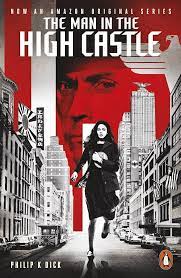The Man in the High Castle: Exploring Philip K. Dick’s Alternative History Masterpiece
Philip K. Dick’s novel, “The Man in the High Castle,” is a captivating exploration of an alternative reality where the Axis Powers emerged victorious in World War II. Set in a dystopian version of America where Japan controls the West Coast and Germany dominates the East Coast, the novel delves deep into themes of power, identity, and resistance.
The narrative follows multiple characters whose lives intertwine in unexpected ways, offering a thought-provoking reflection on what might have been if history had taken a different course. As they navigate this divided world, each character grapples with questions of loyalty, morality, and the nature of reality itself.
Dick’s intricate world-building and meticulous attention to detail create a vivid and immersive reading experience. Through his skilful storytelling, he challenges readers to confront their assumptions about history, politics, and human nature.
“The Man in the High Castle” is not just a work of fiction; it is a profound meditation on the fragility of freedom and the enduring power of hope. It forces us to confront uncomfortable truths about our own society while offering a glimmer of optimism in the face of oppression.
Whether you are a fan of alternative history or simply enjoy thought-provoking literature, “The Man in the High Castle” is a must-read that will stay with you long after you turn the final page.
Unravelling the Layers of ‘The Man in the High Castle’: A Guide to Alternate Histories, Complex Morals, and Shifting Realities
- Pay attention to the alternate history setting where the Axis powers won World War II.
- Explore the complex characters and their moral dilemmas in a world dominated by totalitarian regimes.
- Consider the themes of resistance, loyalty, and identity throughout the novel.
- Analyze how different characters perceive reality and truth in a world filled with propaganda and deception.
- Reflect on the significance of historical events and their impact on shaping society in the novel.
Pay attention to the alternate history setting where the Axis powers won World War II.
In “The Man in the High Castle,” it is crucial to pay close attention to the alternate history setting where the Axis powers emerged victorious in World War II. This pivotal divergence from reality sets the stage for a complex and thought-provoking exploration of what could have been. By immersing oneself in this alternative world where Japan and Germany control America, readers are challenged to consider the implications of such a historical twist on society, politics, and individual lives. Understanding this alternate history backdrop enriches the reading experience, prompting reflection on themes of power, resistance, and the fragility of freedom.
Explore the complex characters and their moral dilemmas in a world dominated by totalitarian regimes.
In “The Man in the High Castle,” readers are invited to delve into the intricate web of complex characters grappling with profound moral dilemmas in a world overshadowed by totalitarian regimes. As they navigate the oppressive reality shaped by victorious Axis Powers, each character’s choices and actions serve as a reflection of their inner struggles against the backdrop of authoritarian rule. This exploration of moral ambiguity and ethical decisions adds layers of depth to the narrative, compelling readers to ponder the enduring complexities of human nature when faced with extreme circumstances.
Consider the themes of resistance, loyalty, and identity throughout the novel.
In Philip K. Dick’s “The Man in the High Castle,” readers are encouraged to delve into the complex themes of resistance, loyalty, and identity that permeate the novel. As characters navigate a world where history has taken a starkly different path, their choices and actions reflect profound struggles with allegiance, morality, and self-discovery. By contemplating these themes throughout the narrative, readers are invited to ponder the intricate interplay between personal beliefs, societal norms, and the enduring quest for individuality in a world shaped by divergent historical forces.
Analyze how different characters perceive reality and truth in a world filled with propaganda and deception.
In Philip K. Dick’s novel “The Man in the High Castle,” a compelling tip for readers is to analyse how different characters perceive reality and truth amidst a world saturated with propaganda and deception. As the characters navigate a society shaped by misinformation and manipulation, their varying perspectives offer profound insights into the complexities of truth and perception. By delving into the nuances of each character’s understanding of reality, readers can unravel the layers of deceit that shroud this alternative history, ultimately leading to a deeper appreciation of the novel’s intricate themes and messages.
Reflect on the significance of historical events and their impact on shaping society in the novel.
In “The Man in the High Castle,” a key tip is to reflect on the significance of historical events and their profound impact on shaping society within the novel’s alternative reality. By delving into how historical outcomes can drastically alter the course of society, readers are prompted to consider the intricate connections between past events and present realities. Philip K. Dick’s masterful storytelling urges us to contemplate the lasting repercussions of pivotal moments in history, highlighting how they can influence societal structures, power dynamics, and individual lives in profound and unexpected ways.

